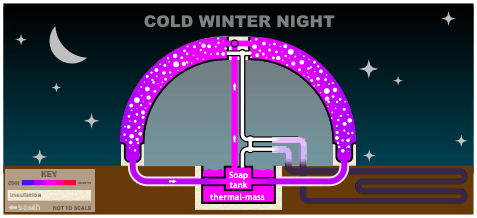Bubble Insulation

Diagram above is for previously considered configuration and does not quite correspond with the text below. An updated diagram will be added shortly.
Night-time Operation
At night, when outside temperatures drop and there is no solar energy available, both north and south cavity are maintained full of liquid bubbles. The bubbles form a thick insulating-blanket around the internal environment. The bubble mass is created at the top of the structure by a bubble generator similar to foam-making machines used by fire-fighters and devices used at foam parties. These devices are discussed in a later chapter. Sheltered from air movement bubbles in the cavity can survive for many hours, but in this system they are replaced before they would naturally evaporate when they cool below a certain temperature.
Temperature of Bubble Insulation at Creation
The same surfactant solution used in collecting solar energy is used again to return thermal energy stored in the thermal mass to the internal building environment. The bubble generation process starts with the surfactant solution passing from its tank via coils in the thermal mass to the bubble generator. Bubble insulation created from this solution will initially have the same temperature as the thermal mass. This is true even though the air that fills the bubbles may be much cooler than the solution. This is due to the high conductivity of water compared to that of the air.
Temperature of the Thermal-mass Throughout the Night
Providing heat is not lost to drafts or dissipated into the ground, the internal environment temperature will not fall below that of the bubble insulation. Therefore, as the bubble insulation is regenerated before it cools significantly, the internal environment will remain close to the temperature of the thermal mass. Surfactant solution returning from the bubble regeneration cycle will have lost its useful thermal energy to the exterior of the building. Successive regeneration cycles will have a cooling effect on the thermal mass, but this is very gradual and by the end of the night it may have lost a few degrees Celsius only. This is because of its massive volume compared to that of the solution required to regenerate the bubble mass.
|